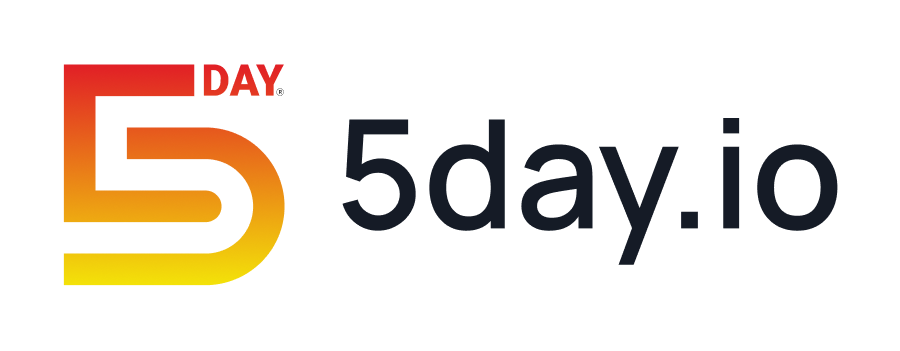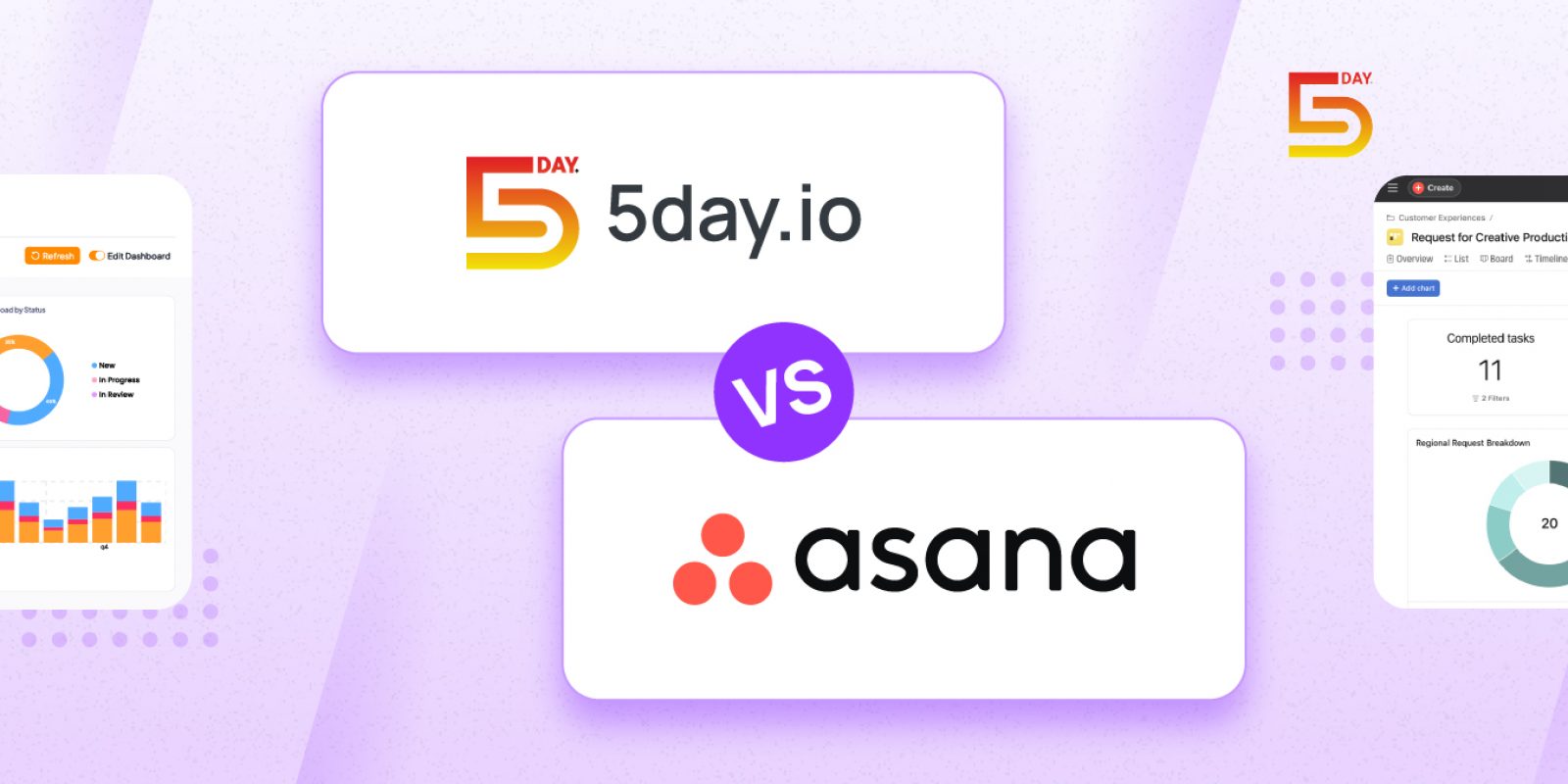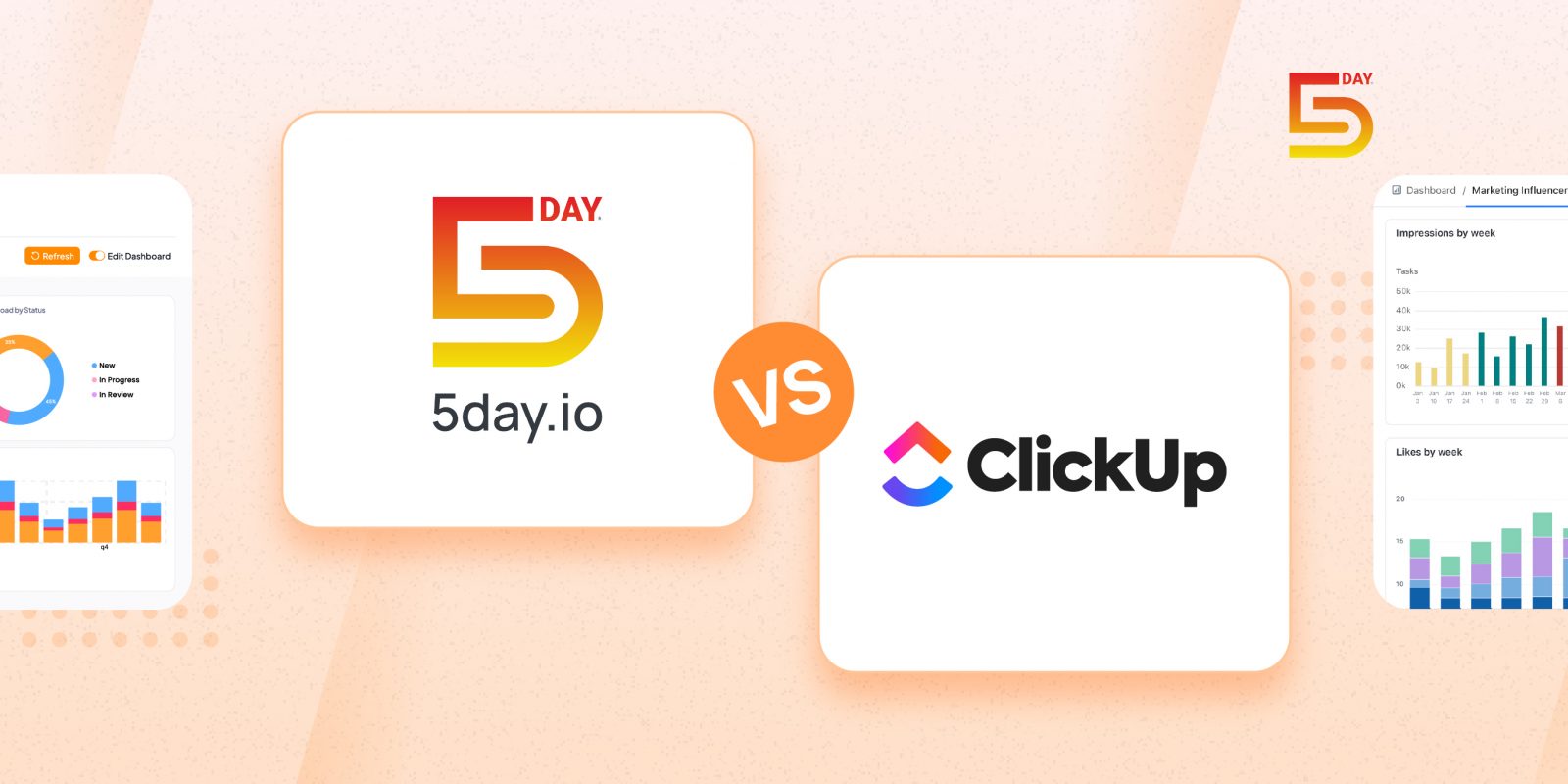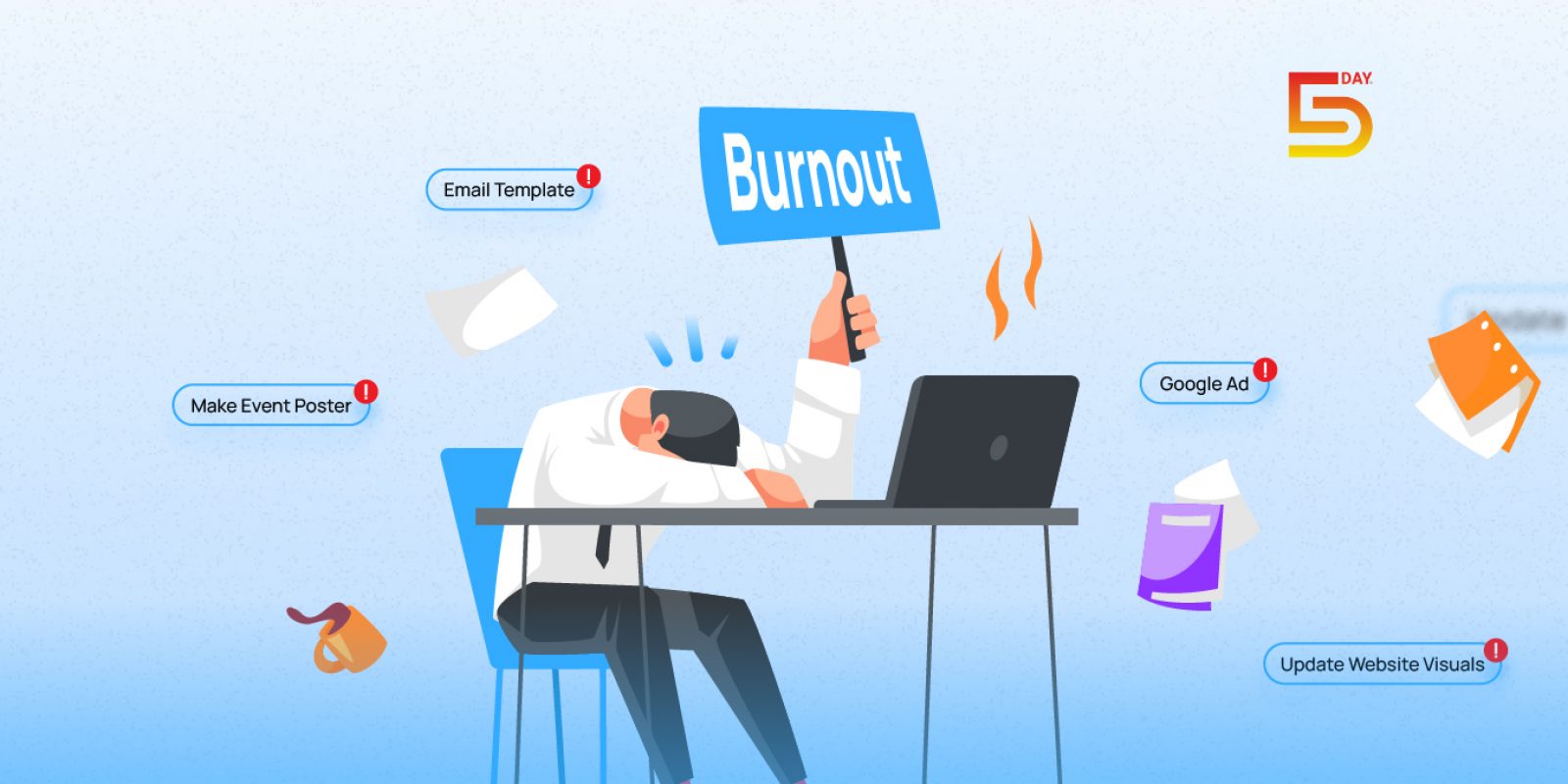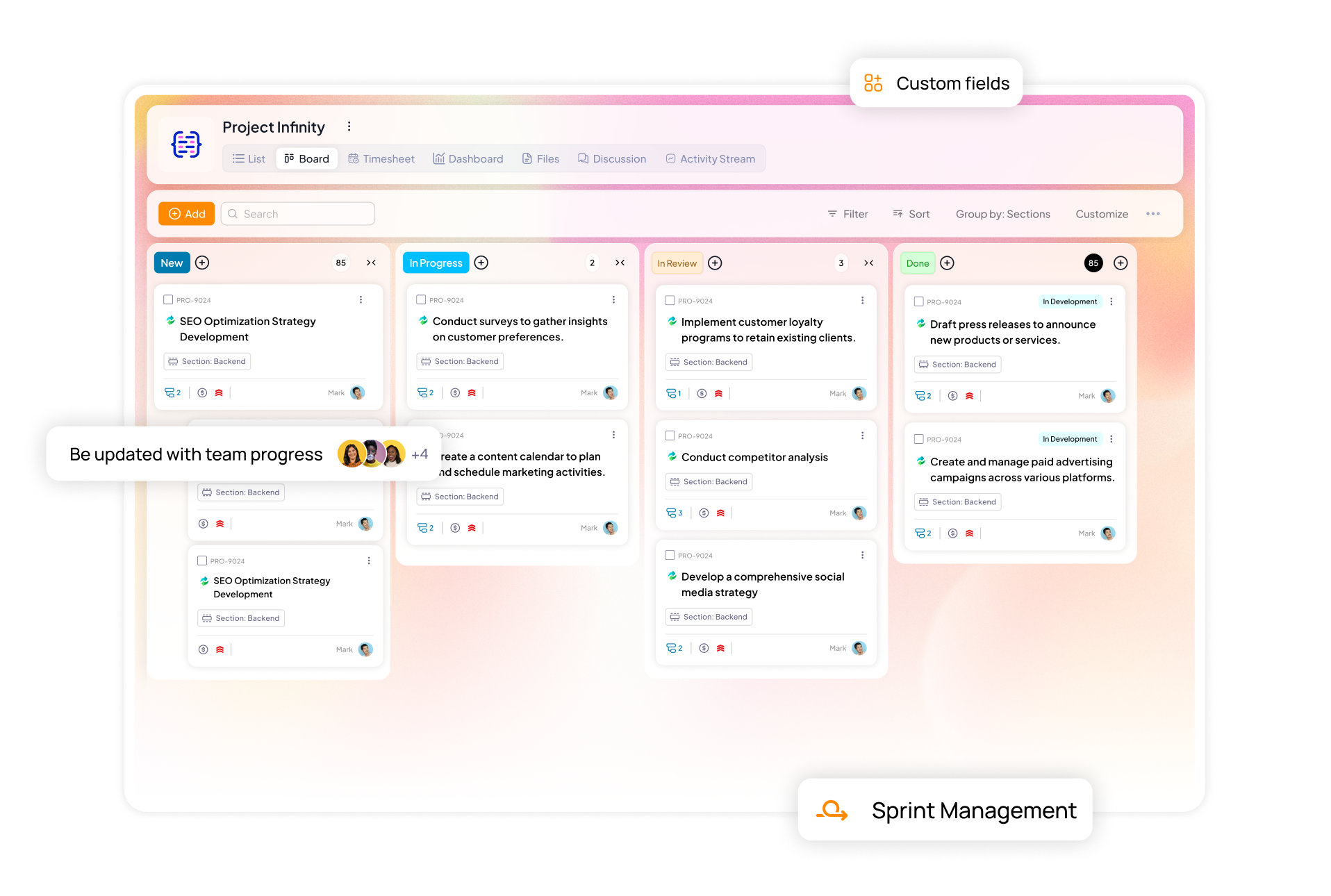ClickUp has long been a fan-favorite among productivity tools, especially within the marketing world.
With its robust feature set, and ambitious promise of being the one app to replace every other business tool, it quickly rose to the top of many teams’ tech stacks.
But as countless marketing teams have discovered, more doesn’t always mean better.
While ClickUp offers a wide range of features, it can quickly become overwhelming. For small to mi d-sized teams, ClickUp’s complexity often ends up getting in the way more than it helps.
This blog is crafted specifically for marketing professionals like you, teams who need tools that support your unique marketing workflows without forcing you to build everything from scratch.
We’ve compared the best ClickUp alternatives for marketing teams, evaluating them based on ease of use, campaign and content planning features, collaboration tools, reporting capabilities, and integrations with marketing platforms.
Why marketing teams look for ClickUp alternatives
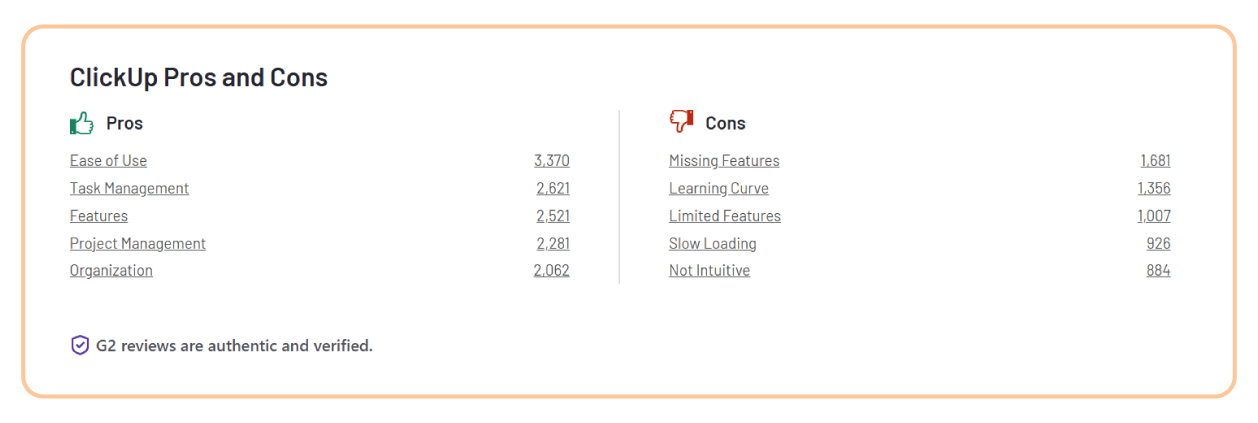
Source: G2
If you’ve found yourself researching what to look for in ClickUp competitors, you’re likely facing some of the same common pain points that others in the marketing world have encountered.
An overwhelming interface designed for engineers—Not marketers
ClickUp’s interface, while feature-rich, often feels like it was built for engineering or product management use cases first. It’s packed with technical options, and advanced nesting structures that can feel intimidating or irrelevant for marketers.
Teams handling content calendars, brand campaigns, or social media workflows often find themselves hacking the tool to make it fit their needs.
For marketing professionals who thrive on visual clarity and straightforward UX, ClickUp’s dense interface becomes a productivity blocker.
Lack of simplicity makes onboarding a headache
For small to mid-sized teams, especially those that work with freelance creatives or onboard new members frequently, ClickUp’s learning curve is steep. Marketing managers often spend days conducting training just to get team members comfortable with the basics.
When clients or collaborators outside the organization need to be involved, it becomes a real problem. ClickUp competitors like 5day.io that prioritize clean, intuitive experiences win here, because marketing teams simply don’t have time to train everyone on a complicated platform.
Feature fatigue slows teams down
One of ClickUp’s biggest selling points, its wide range of features, can quickly become its biggest drawback. From sprints and dependencies to goal-tracking and automations, ClickUp throws everything at the wall. But for most marketing workflows, only a fraction of these features is used.
Read Also: Agile Project Management for Marketing Teams
The rest clutter up the workspace, leading to decision fatigue, and unnecessary distractions. When evaluating alternative to ClickUp, marketing teams should look for tools that offer just the right features.
Limited collaboration across agencies and clients
Agency teams collaborate across functions, departments, other agencies, and clients. Unfortunately, ClickUp’s collaboration model doesn’t always make that easy.
Sharing workspaces, setting permissions, or streamlining creative approvals often involves too many steps or workarounds.
Reporting isn’t built for marketing metrics
ClickUp’s reporting capabilities are flexible, but often too generic. You may be able to build reports, but they usually require custom setups, formulas, and manual updates that aren’t marketing specific.
Whether it’s tracking campaign KPIs, or showing deliverable status, you need tools that provide out-of-the-box custom dashboards. This is a key area for what to look for in ClickUp competitors, reporting that fits the marketing rhythm.
Confusing pricing structures lead to unpredictable costs
ClickUp’s pricing, while reasonable at a glance, can get complicated as your team scales. The per-seat pricing model isn’t always transparent, and many teams struggle to estimate ROI, especially when multiple users don’t need access to all the features.
Agencies, in particular, often need flexible access tiers for contractors, or clients. ClickUp competitors that offer clearer pricing, usage-based models, or marketing team bundles are becoming increasingly attractive.
Best ClickUp alternatives for marketing teams in 2025
5day.io – Intentionally and minimally built software
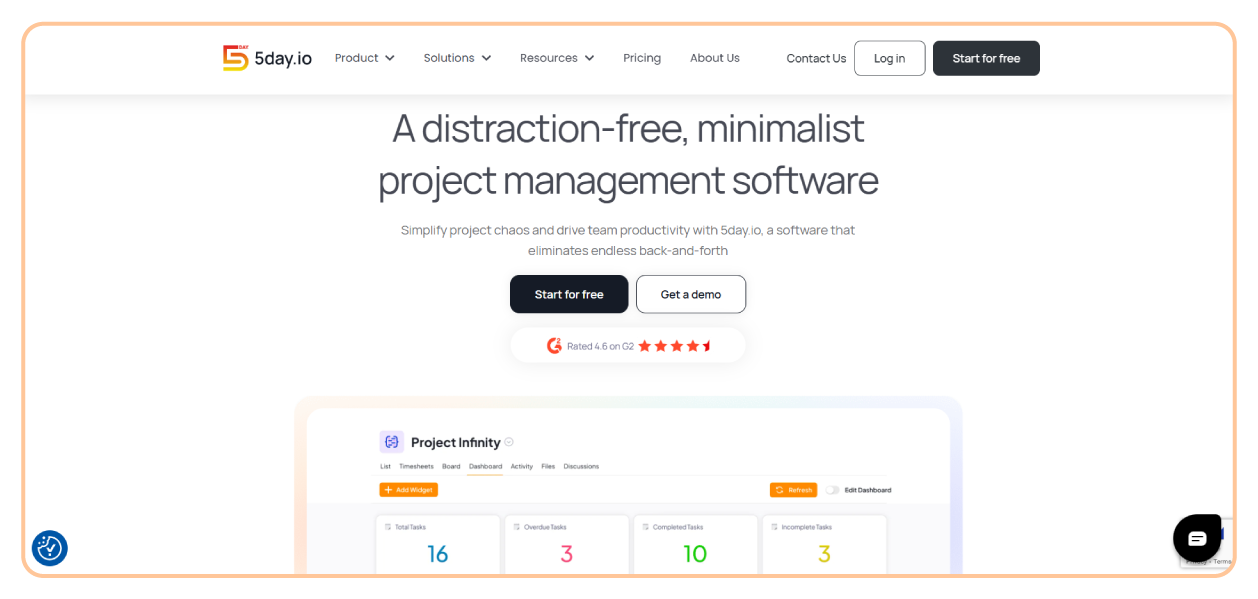
5day.io is becoming the go-to project management software for creative and marketing teams. Unlike generalized platforms, it’s purpose-built to simplify campaign planning, marketing content workflows, breaking down communication siloes, and client collaboration.
Pros:
✅ Built specifically for marketing and creative project management
✅ Time logging, bulk entry, and approval workflows help track project profitability with minimal friction
✅ Helps marketers associate tasks with specific clients, budgets, and billing rules
✅ Makes it easier to manage multi-channel campaigns or high-volume content calendars with layered dependencies
✅5day.io supports granular roles like Client, Guest, and External Member, which is helpful when you’re working with freelancers, vendors, or client-side reviewers.
Cons:
❌ While core tools like Google Drive, Slack, WhatsApp, and Microsoft Teams are supported, marketers relying on Figma, Canva, HubSpot, Mailchimp, or social media platforms won’t find deep native integrations yet.
❌5day.io supports project-level analytics (like time logged, task progress, and capacity), it lacks marketing-specific dashboards for campaign performance (e.g., reach, engagement, lead conversions)
P.S. We will discuss more on why 5day.io is a great alternative for ClickUp users who specifically face challenges with its feature overload.
Trello – Visual campaign boards & lightweight automation
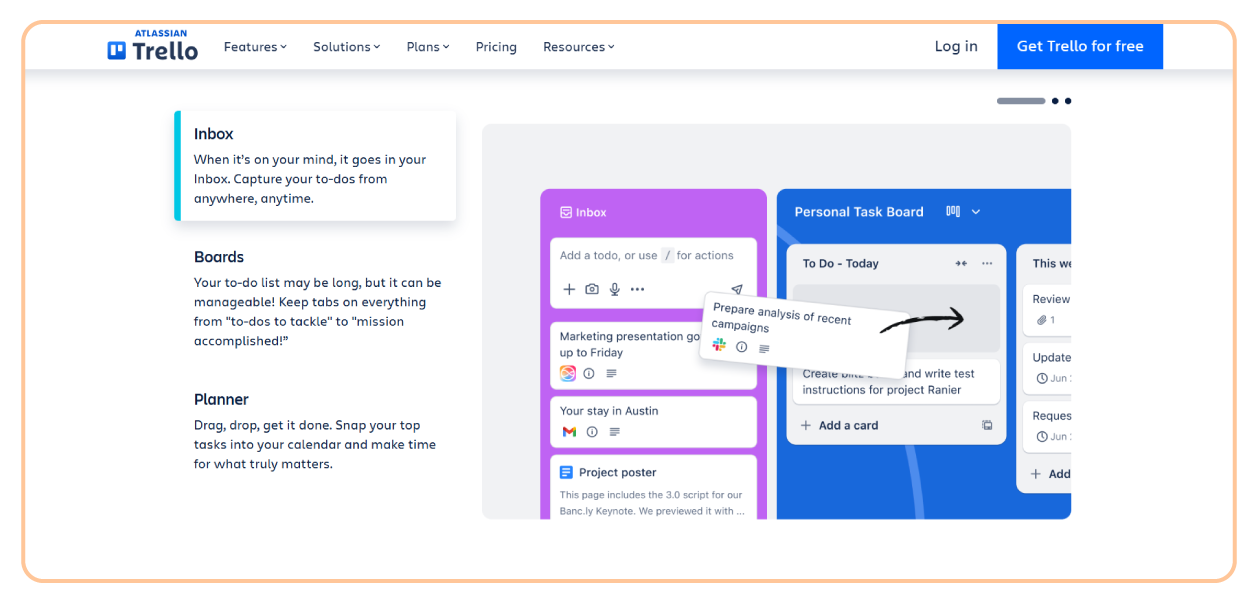
Trello is a visual project management tool built around the Kanban board system, where users can create “cards” for tasks and move them across lists to reflect stages of progress.
Its charm lies in how it lets creative teams organize campaign plans, brainstorm ideas, and monitor progress, all in a highly visual format. Through “Power-Ups,” Trello can integrate with tools like Slack, Google Drive, Mailchimp, and even calendar syncing.
With Trello, you can:
- Drag-and-drop boards with customizable lists bring clarity to campaign stages and content flows. Ideal for content calendars or simple workflows.
- Set triggers (e.g. “when card moves to ‘Review’”) that perform multi-step actions like assigning members, adding checklists, or sending notifications with no code.
- Have visual scheduling tools sync cards to calendar dates and enable drag-to-reschedule features.
- Add integrations like Mailchimp, Figma, Google Drive, Slack
- Get AI-powered automation suggestions detect repetitive tasks and propose rules automatically
- Email or Slack messages convert into Trello cards automatically, with summaries, due dates, and subtasks.
- Track metadata like priority, campaign phase, due dates directly on card using dropdowns, checkboxes, or dates.
- One-click actions (e.g. move card + assign) streamline complex marketing processes.
- Teams can @mention, comment, check tasks off, keeping collaboration within cards.
- Trello loads in seconds across desktop and mobile, making client onboarding frictionless.
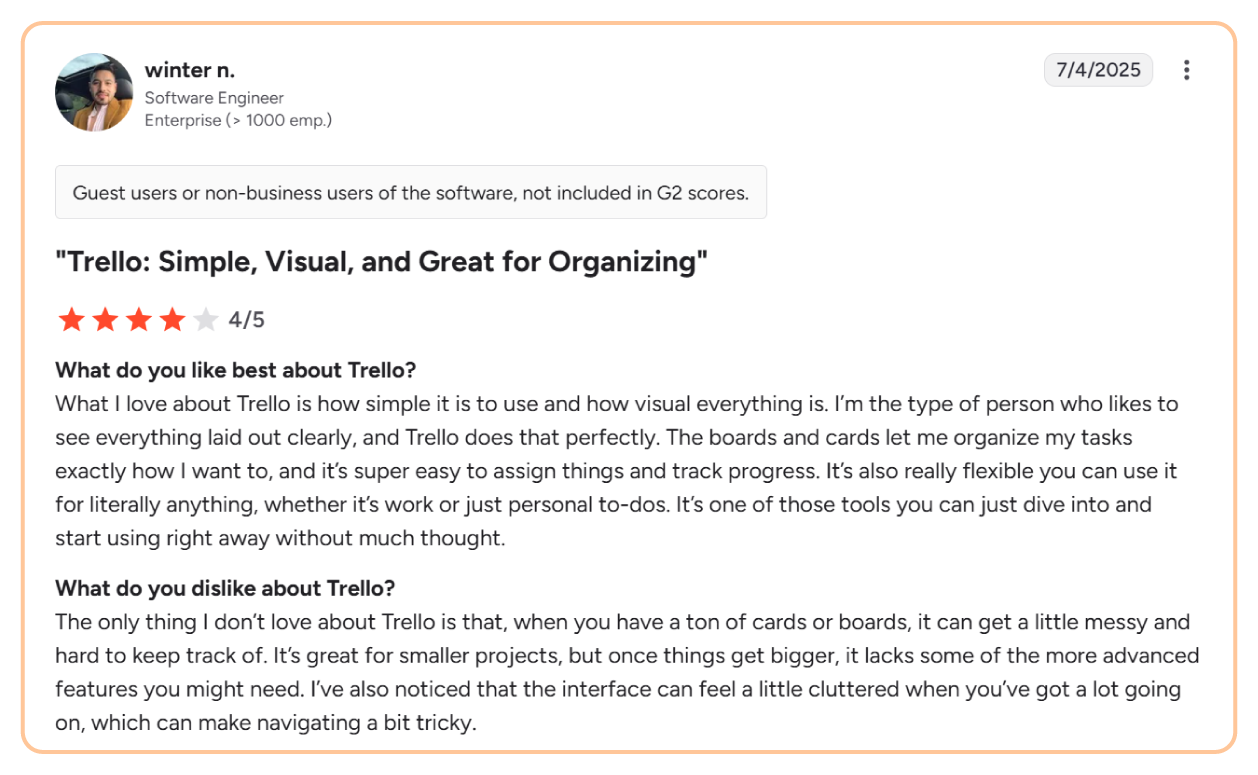
Source: G2
Aspect | Pros | Cons |
Ease of Use | Intuitive drag-and-drop interface; ideal for quick onboarding | Simplicity becomes limiting as teams scale |
Visual Layout | Kanban boards are perfect for content calendars, sprints, and pipelines | No native Gantt view or timeline mode in free plan |
Customization | Power-Ups allow for moderate expansion (e.g., calendar view, Slack) | Limited customization without paid tiers |
Collaboration | Easy card comments, checklists, and attachments for simple team use | Lacks advanced collaboration workflows like approvals or versioning |
Integration | Connects with 200+ apps via Power-Ups (Mailchimp, HubSpot, etc.) | Only 1 Power-Up per board on free plan |
Templates | Prebuilt marketing templates for content calendars, ad planning, etc. | Templates are very basic; lack depth for specialized use cases |
Automation | Built-in Butler automation for recurring tasks and triggers | Butler has limits unless you’re on Business Class or Enterprise plan |
Affordability | Great free tier for small or solo teams | Scaling up becomes expensive; price climbs per user |
Client Involvement | Easily share boards with clients for content approvals | No granular permission levels, can be risky with external collaborators |
Mobile Access | Fully featured mobile app | Offline functionality is limited |
Monday.com – The work OS built for marketing operations
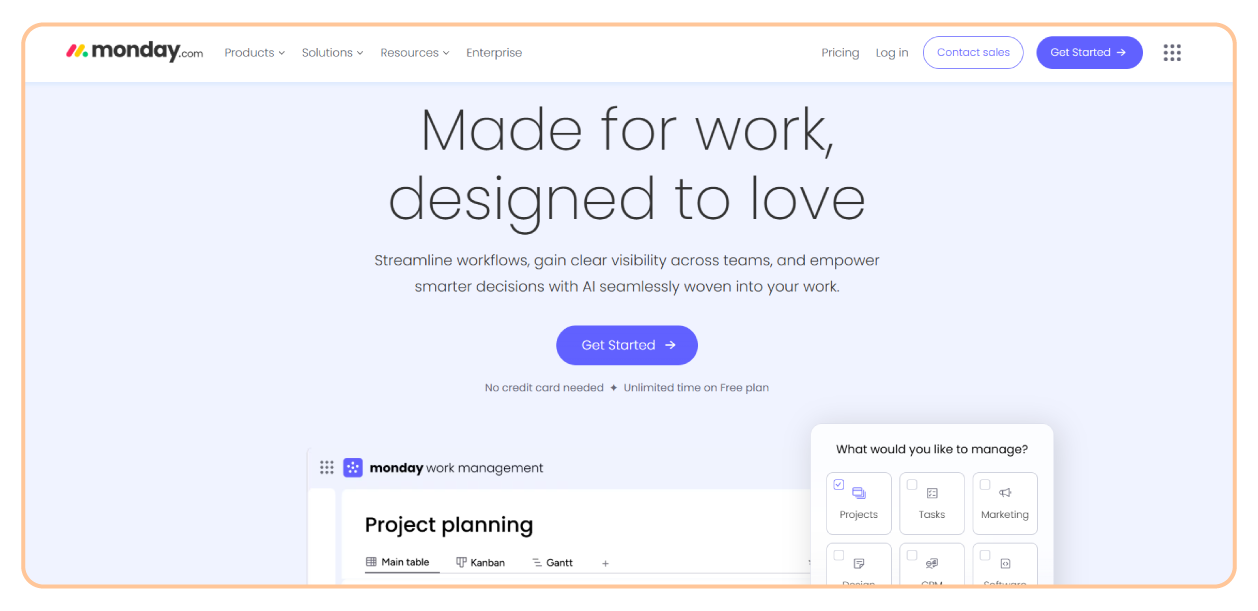
Monday.com is a powerful, fully customizable Work Operating System (Work OS) with tailored workflows for everything from campaign planning to lead tracking, client approvals, and more.
It goes beyond basic task management by letting users create automated workflows, custom dashboards, form-based intake processes, and timeline visualizations, making it perfect for marketing teams that want clarity.
With Monday.com, you can:
- Plan campaign tasks, assets, dates, dependencies, and ownership across multiple team members.
- Use Calendar view + automations to manage publishing, design approvals, and performance tracking.
- Use Forms + Board + Status columns for managing designer requests and revisions.
- Collaborate on campaign copy, set deadlines, sync with Mailchimp/HubSpot, track A/B testing.
- Use CRM board view to track leads, statuses, and conversion metrics.
- Visualize timelines, assign owners, and integrate logistics and marketing prep.
- Track budgets, spend, performance, traffic, and conversion data in one place.
- Ensure no team member is overloaded by using Workload view.
- Automate notification chains for manager/client approvals based on status change or due date.
- Use Templates + Permissions to seamlessly onboard and manage external collaborators.
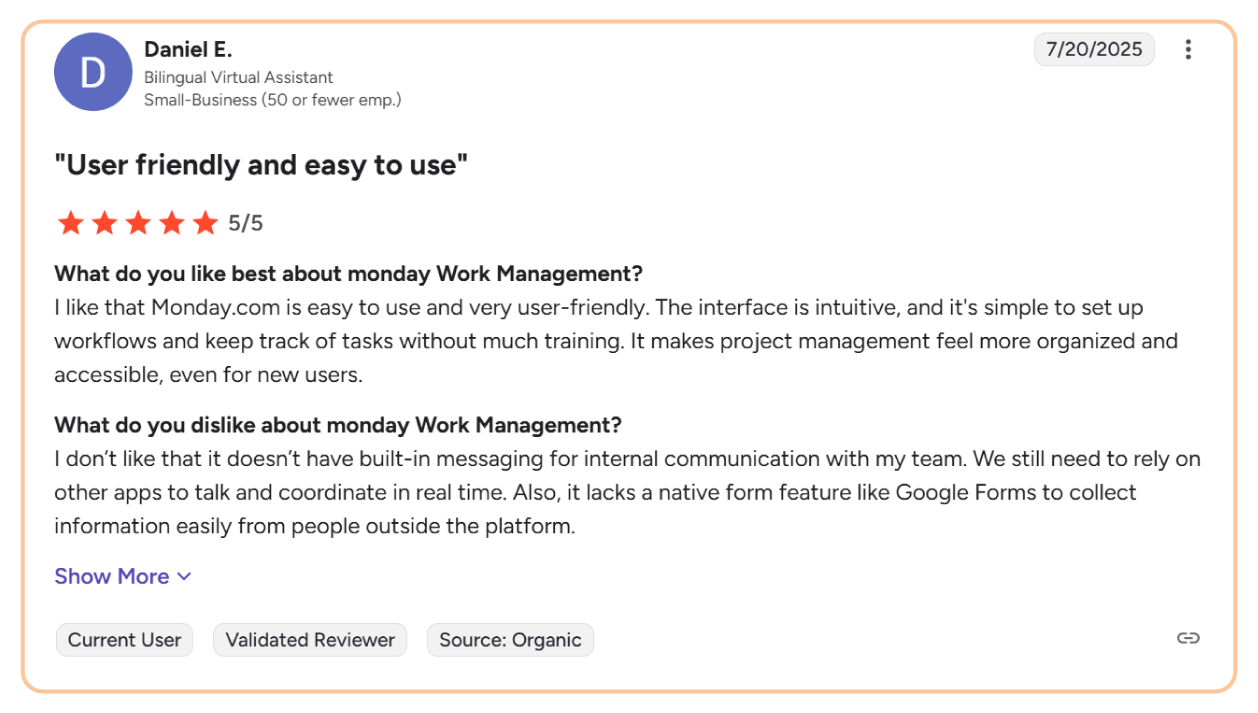
Source: G2
Aspect | Pros | Cons |
Customization | Fully customizable boards, columns (status, numbers, text, timeline, people, tags, etc.) | Steeper learning curve due to sheer customizability |
Views | Supports multiple views: Table, Kanban, Calendar, Timeline, Gantt, Workload, Forms | Gantt & workload views are locked behind paid tiers |
Marketing Templates | Dozens of templates for content calendar, brand asset management, campaign tracking, CRM | Templates can feel generic without tweaking |
Automation | No-code automation for reminders, recurring tasks, status updates, emails, Slack, etc. | Automations have monthly limits depending on plan tier |
Dashboards | Visual dashboards for KPIs, campaign progress, lead pipelines, budget tracking, ROI reporting | Dashboard features limited in free & basic plans |
Collaboration | Built-in real-time updates, @mentions, file attachments, client request forms | Can get noisy with too many updates if not filtered |
Client Management | Intake forms + workflow tracking = seamless lead or brief management | External users (clients) require specific setup for access control |
Integrations | Deep integrations with HubSpot, Facebook Ads, Google Ads, Mailchimp, Zapier, Slack, etc. | Some integrations only available on Standard plan and above |
Reporting & Analytics | Custom dashboard widgets for marketing ROI, team workload, campaign analytics | Advanced reports (cross-board) need higher-tier plans |
Scalability | Excellent for large teams with interdependent departments, freelancers, and agencies | Can feel “too much” for freelancers or small teams just needing simple to-do lists |
Asana – A clean, scalable choice for marketing workflows
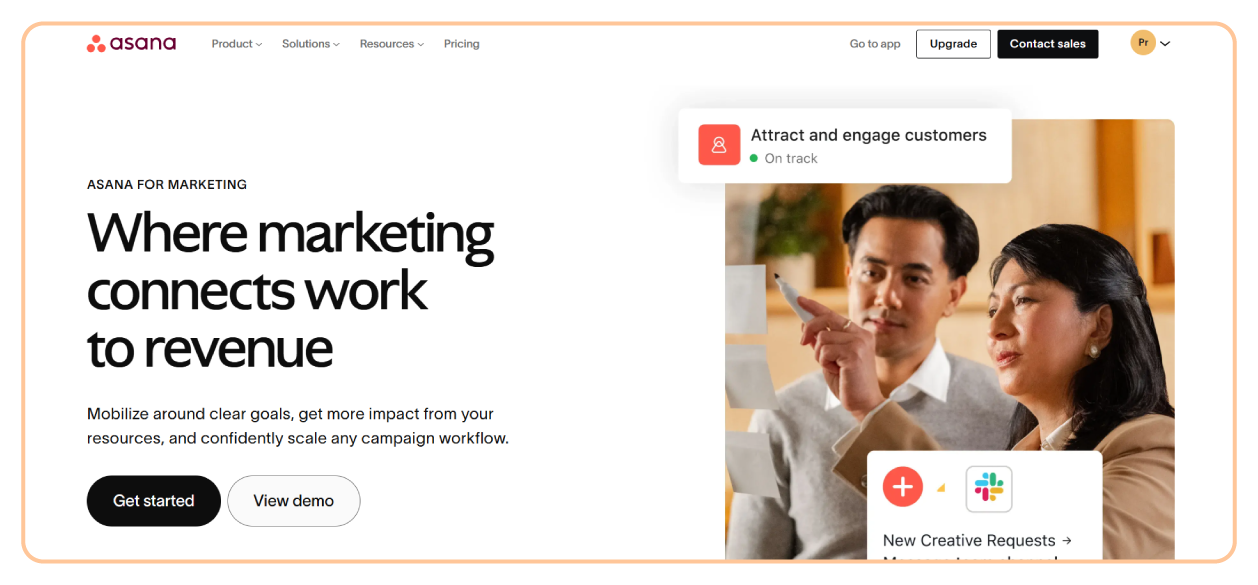
Asana is one of the most widely adopted project management tools, known for its simplicity, and scalability.
It’s popular among marketing teams thanks to its intuitive structure that balances task management with big-picture campaign planning.
While it wasn’t originally built just for marketing, Asana’s flexible project views (like Lists, Boards, Timelines, Calendars), pre-built templates, and content production workflows make it a strong contender for cross-functional teams managing everything at once for several clients.
Asana also integrates smoothly with creative and communication tools (Figma, Slack, Google Drive, Canva).
With Asana, you can:
- Have List, Board, Calendar, and Timeline views to manage campaigns in your preferred style.
- Assign tasks, set deadlines, subtasks, and manage dependencies
- Use pre-built or custom templates for product launches, and content calendars
- Comment directly on tasks, and attach files for contextual conversations
- Seamlessly connect with Slack, Google Drive, Figma, HubSpot, and other marketing tools
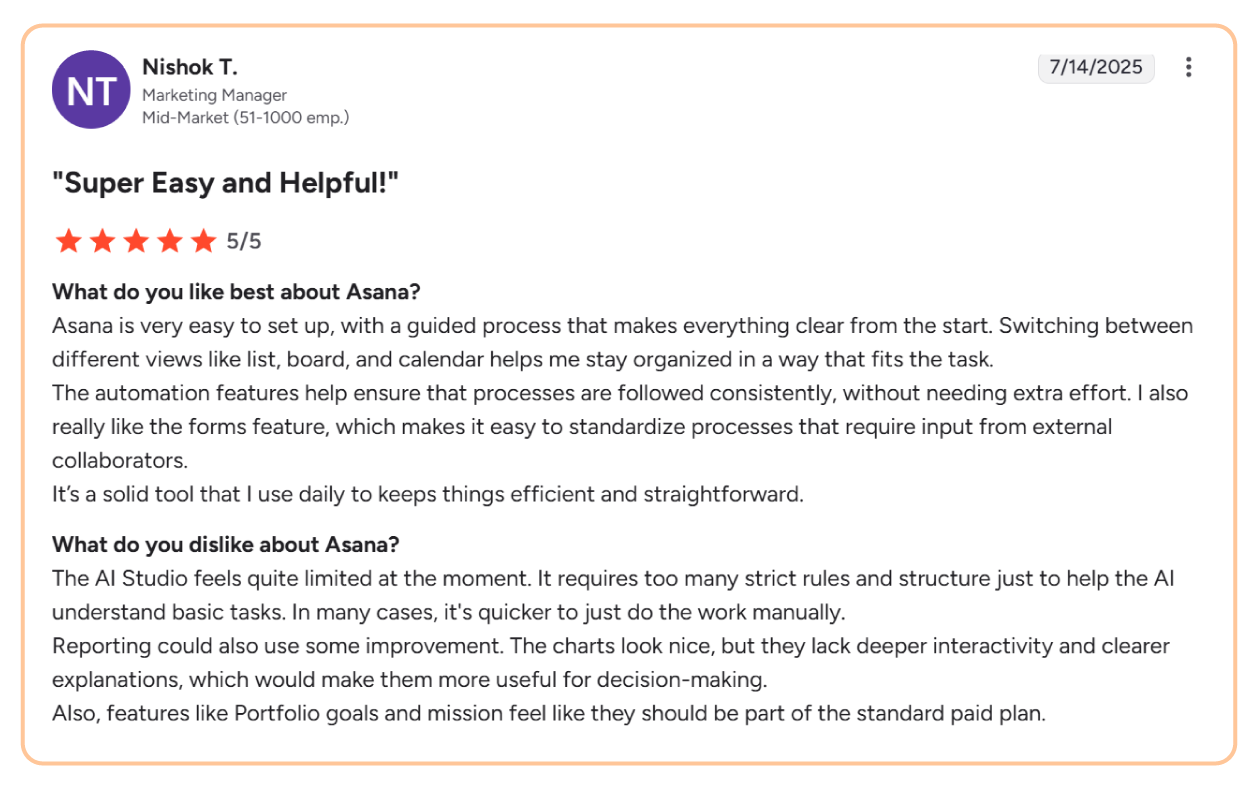
Source: G2
Feature | Pros | Cons |
User Interface (UI) | Clean, clutter-free, and fast to pick up | Less visual than tools like Trello or 5day.io |
Task & Subtask Management | Great for breaking down projects into granular steps | Subtasks can become hidden and hard to manage |
Calendar & Timeline Views | Perfect for campaign planning and editorial calendars | No native Gantt chart unless you’re on Premium |
Workload Management | Helps visualize team capacity and avoid burnout | Only available in Business/Enterprise plans |
Project Templates | Marketing templates for content calendars, launches, email campaigns | Customization may require time and internal tweaking |
Automation Rules | Reduces repetitive manual work with triggers and actions | More limited than advanced automation tools like Airtable |
Integration Ecosystem | Strong ecosystem: Slack, Google Workspace, Canva, Figma, Salesforce | Some integrations may require third-party tools like Zapier |
Reporting & Goals | Goal-tracking tied to tasks for OKRs, KPIs | Not as advanced for creative performance or ROI metrics |
Collaboration & Comments | Threaded task comments + @mentions streamline async communication | No native creative review or visual markup tools |
Scalability | Scales well from small teams to large orgs | Becomes expensive as teams grow; pricing per seat increases fast |
Teamwork – Agency-grade project management & client collaboration
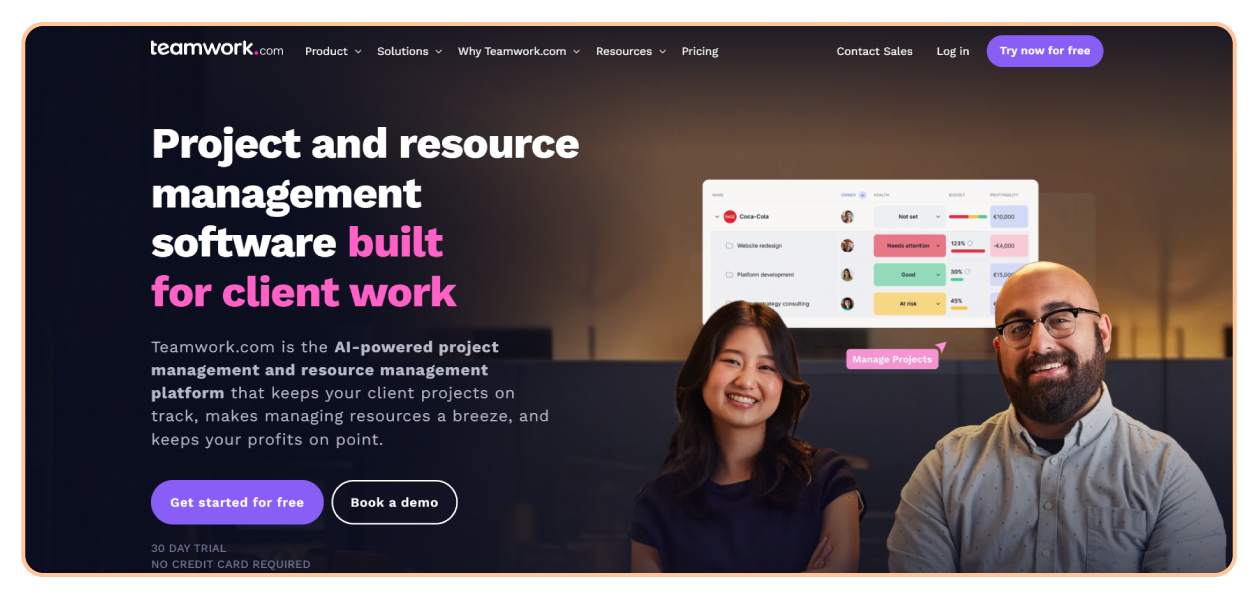
Teamwork is a project management platform specifically designed to help agencies, and businesses juggling multiple clients streamline their work.
Founded in 2007, Teamwork has grown to serve businesses in over 180 countries, offering a suite of products that go beyond just task management, such as time tracking, billing, client collaboration, workload planning, and resource management.
With Teamwork, you can:
- Create individual tasks and sub‑tasks, assign due dates, priorities, and followers. Tasks can be grouped into projects and easily organized using tags and milestones.
- Choose from List, Board (Kanban), Table, or Gantt Chart views for flexible project visualization. All views support drag‑and‑drop scheduling and real-time updates.
- Use interactive Gantt timelines to set dependencies, track milestones, adjust due dates, and identify bottlenecks at a glance
- Visualize team capacity and allocation to ensure no one is overloaded. Reassign or rebalance tasks as needed for optimized throughput
- Invite clients or freelancers as guests, assign limited permissions, and share project status or assets without risking access to internal data. Particularly useful for creative approvals and feedback loop
- Configure no-code automation rules, like moving tasks after completion or sending status reminders, to streamline recurring campaign workflows and reduce manual updates
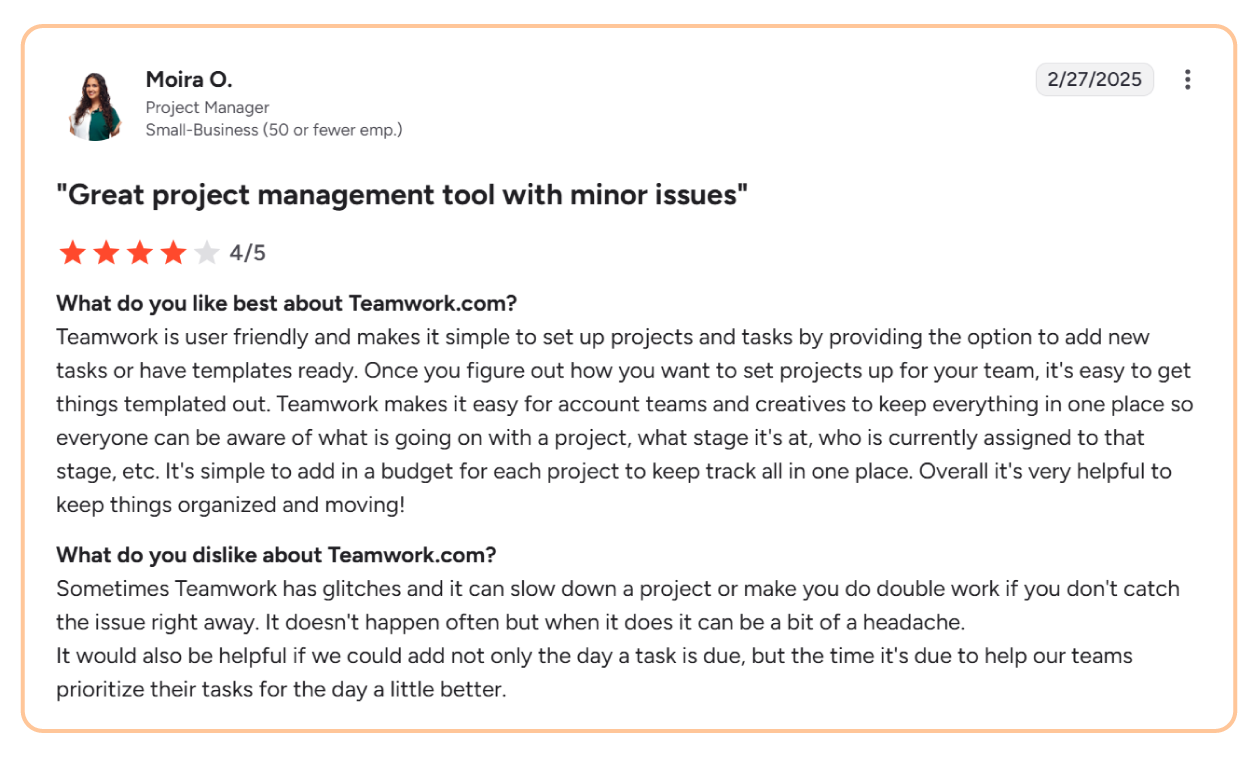
Source: G2
Feature Category | Pros | Cons |
Workspaces & Views | Highly customizable with pages, sub-pages, and multiple view types (Kanban, Timeline) | Easily becomes cluttered or disorganized without strict structure |
Task Management | Decent for basic project/task tracking with due dates, tags, and views | No native task dependencies, workload view, or advanced PM features |
Knowledge Management | Excellent for SOPs, campaign docs, content calendars, and internal wikis | Not ideal for teams needing more structured documentation control or versioning |
Reporting & Dashboards | Can build custom dashboards using linked databases, rollups, and formulas | No out-of-the-box reporting or visual dashboards |
Automation & Integrations | Zapier/Make integrations allow basic workflow automation | Lacks native automations and deeper integrations compared to tools like ClickUp or Teamwork |
Collaboration | Easy to comment, mention, and share with team or external collaborators | No real-time multi-user editing visibility; limited in notifications |
Docs & Content Creation | Great for writing, drafting, and embedding rich media; AI assists with copy creation | Formatting can be fragile; not ideal for polished exports |
Permissions & Access | Flexible page-level sharing and visibility | Limited admin controls and granular permissions |
AI Features | Useful for summarizing, rewriting, brainstorming content | Requires paid add-on; not deeply contextual for project-specific needs |
Mobile & Offline Access | Mobile app works well for quick edits and notes | Offline editing is limited; syncing issues can occur |
Notion – The productivity workspace that everyone thinks is easy to handle
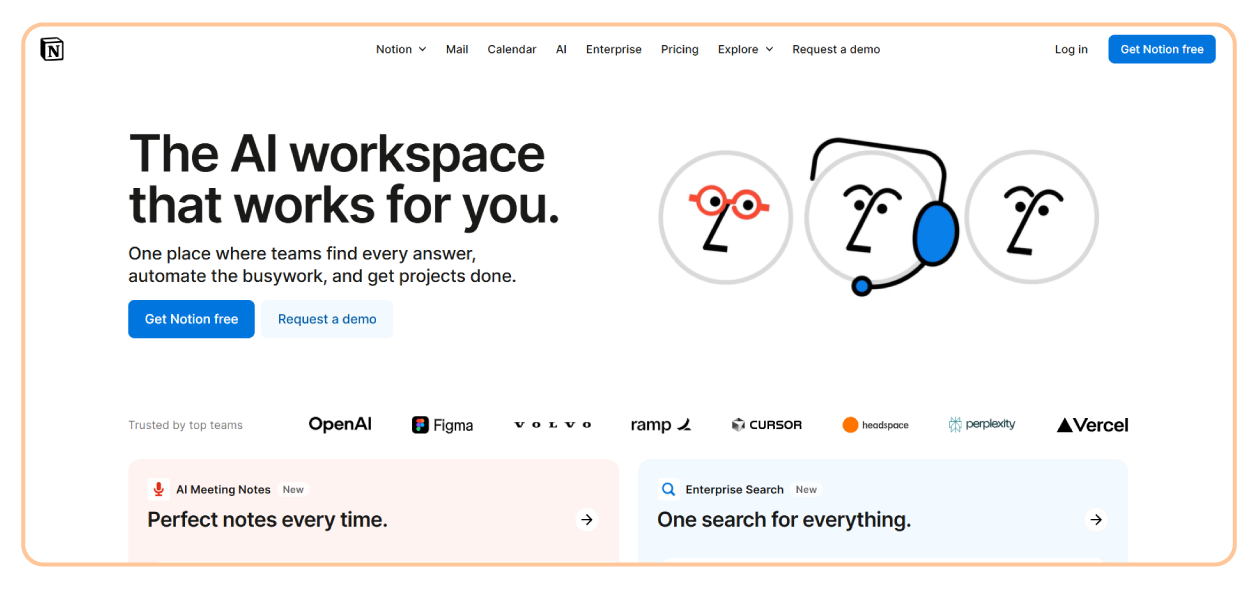
Notion is an all-in-one productivity workspace that combines notetaking, task management, databases, and collaboration under one flexible platform. Originally launched as a tool for personal use and small teams, Notion has evolved into a customizable operating system.
What sets Notion apart is its modular block system, which allows users to build anything without any coding.
With Notion, you can:
- Drag and drop, duplicate, nest, or customize blocks in endless ways.
- Create a central database (e.g., “All Campaigns”) and show filtered views (like “Q3 Launches” or “Assigned to Me”) across multiple pages. Every view is synced and live.
- Change how you view your data with a single click
- Notion lets you create a full documentation hub, whether it’s SOPs, team onboarding docs, project folders, or a full-blown knowledge base.
- Embed Google Docs, Sheets, Loom videos, Figma files, GitHub code, and even weather widgets into any page.
- Has thousands of built-in and user-created templates across categories like product roadmaps, marketing campaign calendars, personal goal trackers, and CRM systems
- Control visibility at the page or database level. Invite members or make public links.
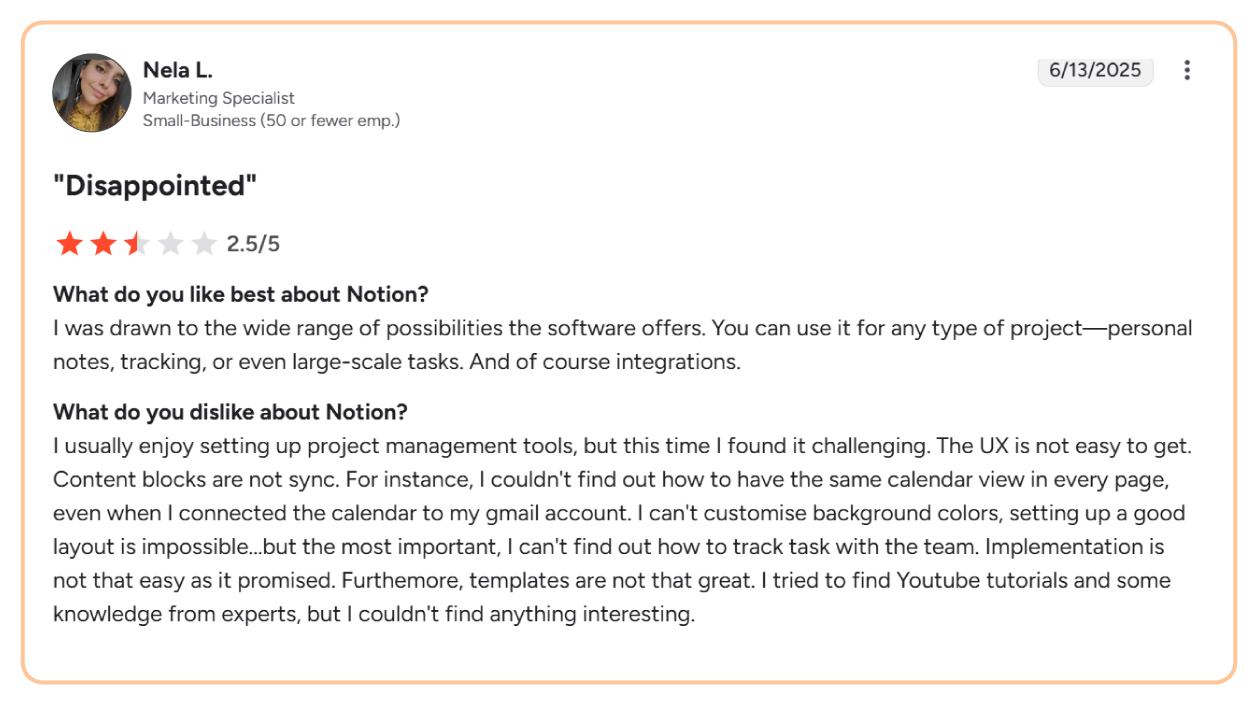
Source: G2
Feature Category | Pros | Cons |
Workspaces & Views | Highly customizable with pages, sub-pages, and multiple view types (Kanban, Timeline) | Easily becomes cluttered or disorganized without strict structure |
Task Management | Decent for basic project/task tracking with due dates, tags, and views | No native task dependencies, workload view, or advanced PM features |
Knowledge Management | Excellent for SOPs, campaign docs, content calendars, and internal wikis | Not ideal for teams needing more structured documentation control or versioning |
Reporting & Dashboards | Can build custom dashboards using linked databases, rollups, and formulas | No out-of-the-box reporting or visual dashboards |
Automation & Integrations | Zapier/Make integrations allow basic workflow automation | Lacks native automations and deeper integrations compared to tools like ClickUp or Teamwork |
Collaboration | Easy to comment, mention, and share with team or external collaborators | No real-time multi-user editing visibility; limited in notifications |
Docs & Content Creation | Great for writing, drafting, and embedding rich media; AI assists with copy creation | Formatting can be fragile; not ideal for polished exports |
Permissions & Access | Flexible page-level sharing and visibility | Limited admin controls and granular permissions |
AI Features | Useful for summarizing, rewriting, brainstorming content | Requires paid add-on; not deeply contextual for project-specific needs |
Mobile & Offline Access | Mobile app works well for quick edits and notes | Offline editing is limited; syncing issues can occur |
5day.io – The marketing-first alternative to ClickUp
This isn’t another “universal” PM tool trying to force you into workflows meant for someone else.
5day.io is purpose-built for marketing teams.
It understands how your day really looks, and the pressure to deliver ROI fast. You need to plan, execute, and deliver fast. 5day.io strips away the unnecessary. Just clean, intuitive layouts that help you hit the ground running.
Read Also: How Poor Project Management Leads to Poor Marketing ROI
Agile enough for agencies, friendly enough for small teams
Marketing teams come in all shapes and speeds. Whether you’re a boutique agency managing ten brands, or a three-person in-house team building your first product launch, 5day.io scales with you.
Agencies can manage multiple clients effortlessly, with dedicated sections, role-based views, and approval layers. Each client has their own workflows, branding, deliverables, and deadlines, all unified in a single dashboard that’s as flexible as your team needs it to be.
Small teams, meanwhile, won’t drown in features.
You’ll find an uncluttered environment, with a balanced structure to get things done along with customization to shape your own system.
Packed with features built for marketers
You need tools that adapt to your campaigns, content strategies, and client dynamics.
5day.io delivers on that, with features like:
- Visual content calendars that give you a bird’s-eye view of publishing timelines
- Approval workflows that simplify reviews and prevent bottlenecks
- Built-in templates for paid media ops, SEO sprints, social campaigns, and launch checklists
- Live team-client collaboration that replaces messy email threads and vague notes
Use cases that mirror your reality
5day.io molds itself to your reality.
In-house teams can streamline planning, content approvals, and performance tracking across internal stakeholders without needing six separate tools. Agencies get repeatable workflows done without chaos.
If your team is growing fast and needs to stay organized without killing creativity, this is the tool.
Why 5day.io is the best ClickUp alternative for marketing teams
Client collaboration comes first
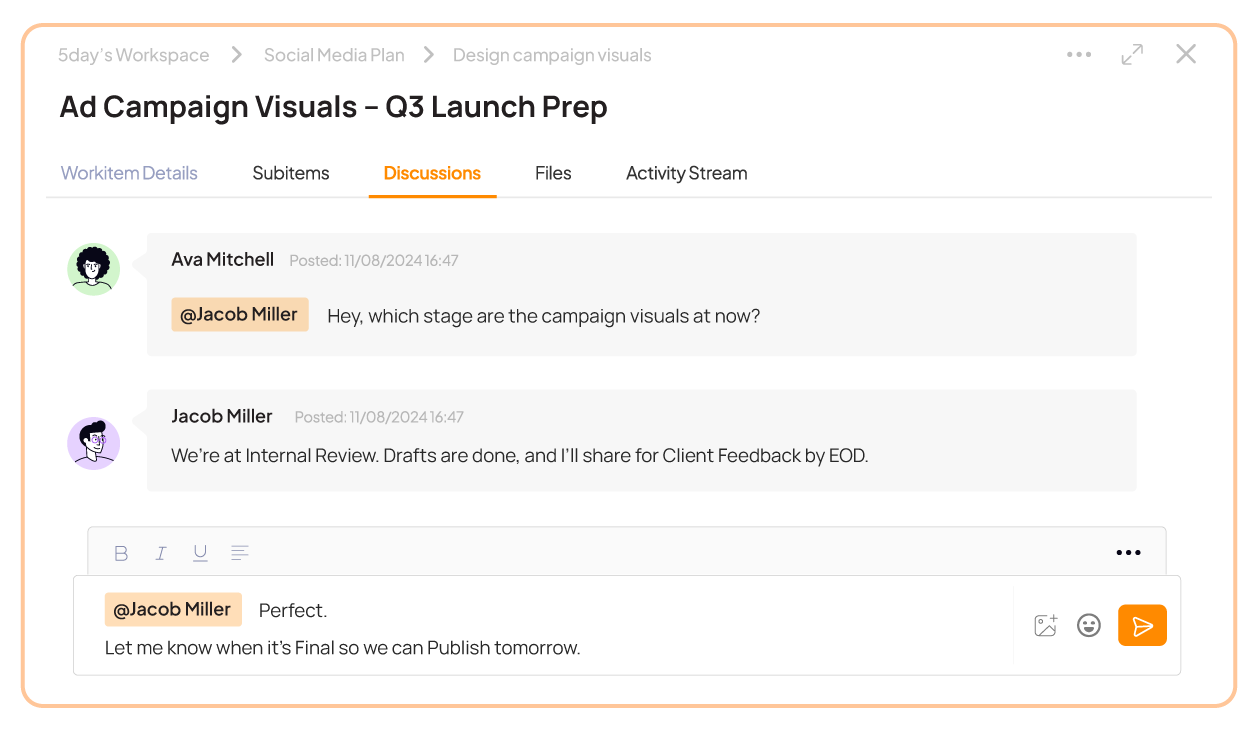
With other tools, either you’re paying for extra seats, or pasting endless links into email threads. 5day.io removes all that friction. You can give project-specific access to clients, and they will be able to see changes in real-time.
Campaign templates that actually reflect how you work
From ad campaign planning, blog post planning, campaign management, content calendars, email marketing and event planning templates, everything is pre-structured for how you already work. You just pick a template, adjust a few fields, and go.
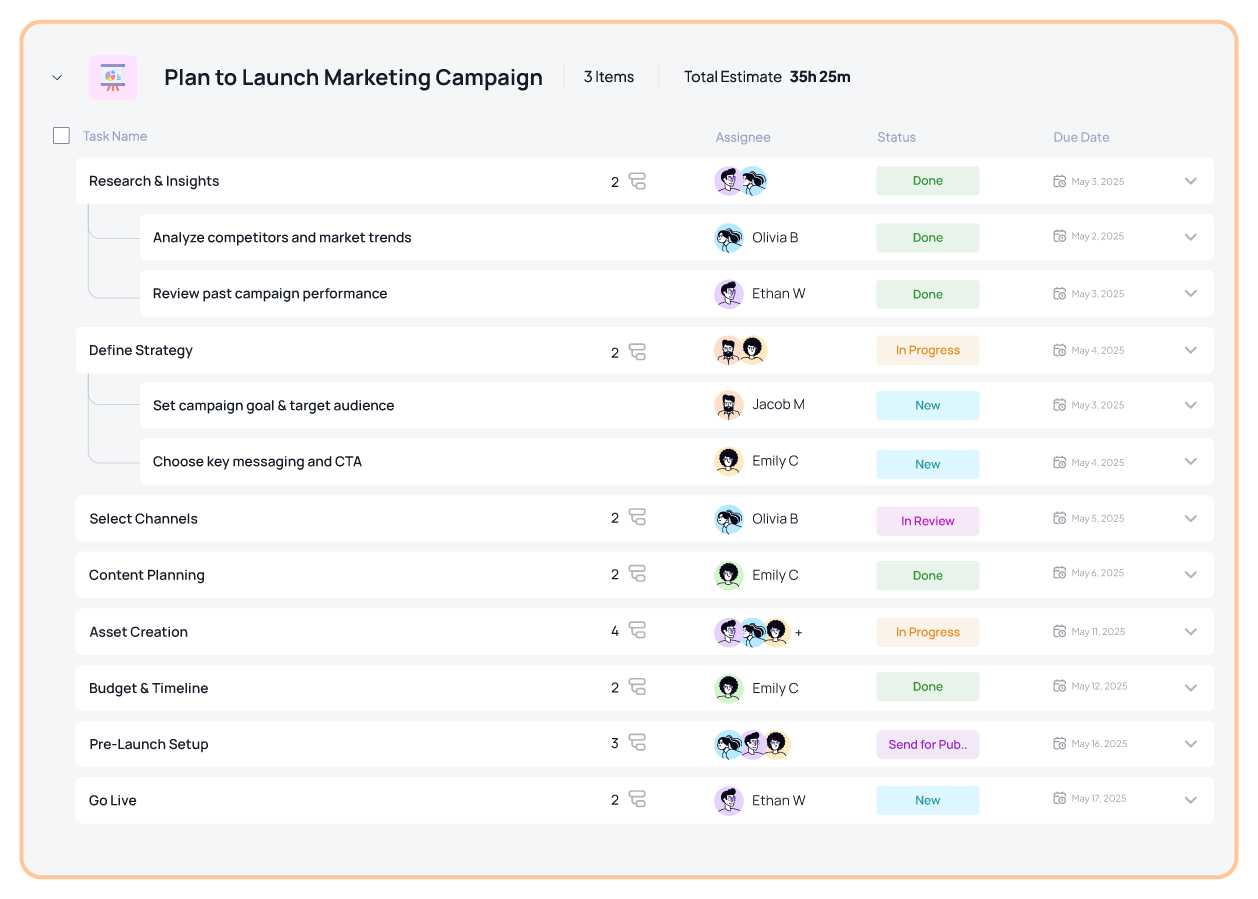
Simple, beautiful and powerful
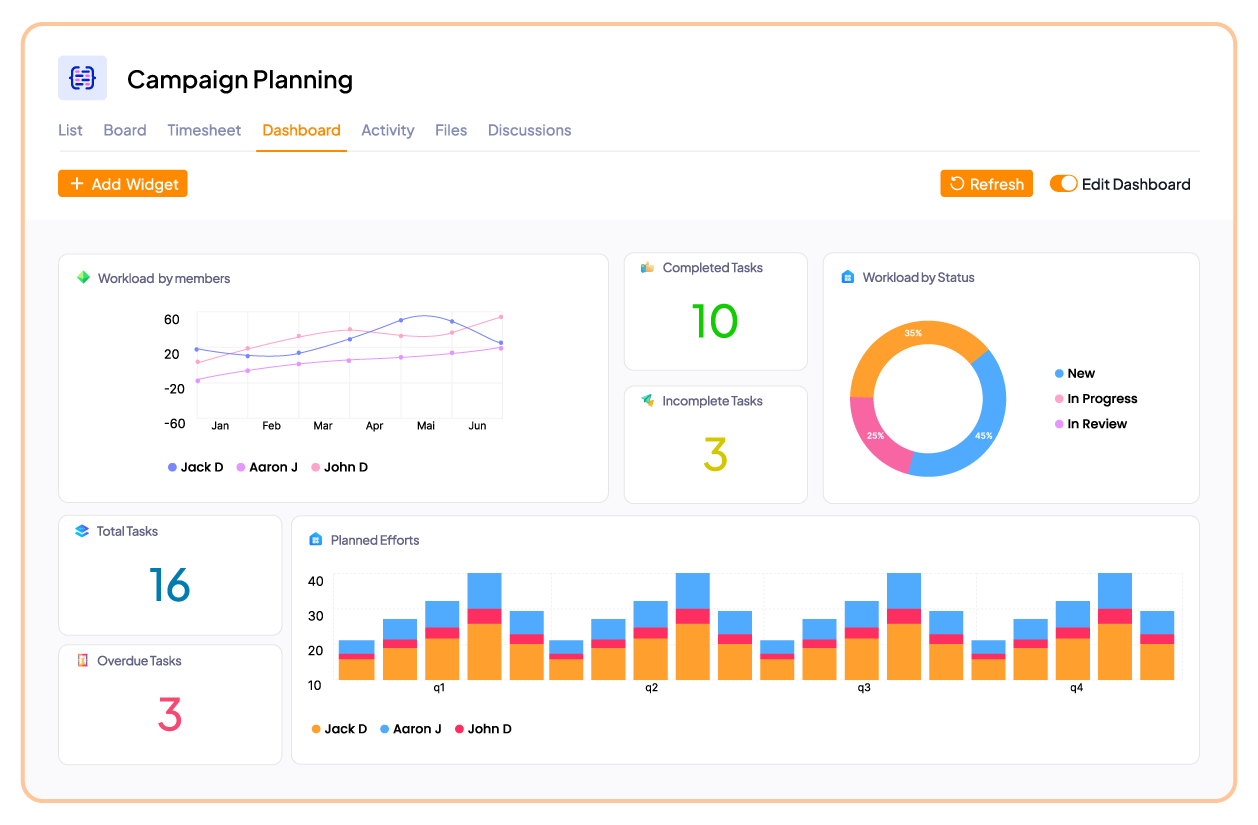
You shouldn’t need a manual to understand your own dashboard. With 5day.io, you don’t.
Everything is crafted for maximum clarity. Want to see what’s in review across all clients? Done. Need to filter by teammate, campaign, or status? One click.
This is simplicity that amplifies your power at the agency.
Setup that takes hours, not weeks
ClickUp can take days, or even weeks to configure. With 5day.io, you’re up and running in under an hour.
- Import your tasks from Excel, Trello, or ClickUp.
- Invite your team.
- Pick your campaign template.
- Start delivering.
No IT. No steep onboarding.
Conclusion – Find a tool that thinks like a marketer
ClickUp is, without question, a powerful platform. But the truth is most marketing teams quietly realize, just because a tool can do everything doesn’t mean it should.
If your team has ever felt bogged down by complexity, or overwhelmed by setup time, you’re not alone.
Many marketing teams who start with ClickUp eventually find themselves drowning in features they don’t use and spending more time managing the tool than managing the work.
That’s not what marketing needs.
Your team can’t afford to lose momentum inside a bloated system that wasn’t designed for them in the first place. That’s where 5day.io makes a difference.
It’s smarter, more focused project management software for marketing agencies that understands the unique pressures and rhythms of marketing work. To view the tool in all its glory, start a 3-month free trial today. No strings attached. You get full customer support and access to the full suite of features even during a free trial.
